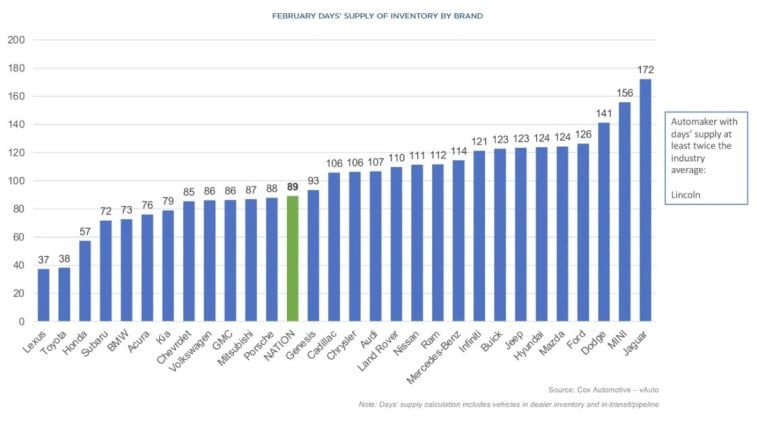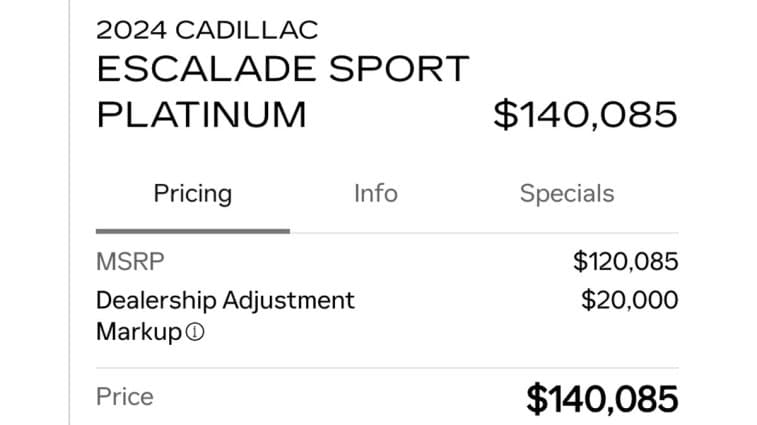

Quick Facts About Car Prices
- Tariffs could change the landscape of car prices and markups.
- Inventory improved significantly at many dealerships.
- Hard-to-find vehicles include mainstream Asian brands and Japanese and European luxury car marques.
While finding a new car today is easier than in recent years, tariffs could change the landscape of car prices, potentially giving rise to markups.
While the search could become tricky, striking a good deal doesn’t need to be. Right now, dealers are offering Incentives on new vehicles as inventories remain at pre-COVID-19 norms. Still, on specific, highly anticipated models, you’ll still need to guard against any dealers treating a short supply of cars like a winning lottery ticket. You may see some tack on thousands of dollars in dealer markups to the manufacturer’s suggested retail price (MSRP). By law, every new car’s window sticker must display the MSRP.
It is best to read several dealer reviews before arriving at the dealership. For models in short supply, vehicles arriving on transport trucks will often be presold or at least promised. It’s an oscillating market for some car shoppers. In this article, we’ll explain markups and market adjustments, why dealers use this practice to increase prices of new vehicles beyond MSRP, and what, if anything, you can do about it. The good news is that the practice has subsided substantially since the crazy pandemic days.
What’s Supply Got to Do With It?
If you start shopping for a new car, you may encounter dealers who refuse to budge from the vehicle’s posted window sticker price. In other words, they aren’t willing to negotiate.
New car inventories returned to normal for most automakers but remain exceedingly tight for some. According to data from Kelley Blue Book’s parent company Cox Automotive, new car transaction prices neared $48,039 at the end of February. That’s 1% higher than the same time last year. Car prices remain about $10,000 higher than pre-pandemic times.
The new vehicle inventory was nearly 3 million units, or 89 days of supply, in February. That’s better than it was in February 2024.


Every car a dealer sells today will be unavailable to sell tomorrow. That’s always the case. However, some dealers at car brands like Lexus, Toyota, and Honda have potential buyers lined up as if it’s an opening day for a viral movie. At the same time, others stock an oversupply of vehicles, like Lincoln, Dodge, and Ford.
Car Prices Determined by Supply and Demand
If you don’t pay much attention to the fundamental theories of economics, you may not realize the current marketplace works like a Petri dish for the effects of supply and demand. In an open market, demand dictates prices. The more people want a thing (like cars), the more they are willing to pay for it, and the higher its price goes. That higher demand motivates additional production of that thing, and the price eventually falls.
Car dealers do not exist in business to break even. When you find your dream car and the dealer wants the full MSRP — or more — you can always walk away. Waiting for that dealer to return with a better offer probably isn’t the best use of your time. If it’s a popular model and you wait, someone else might snatch it up.
These days, a dealer sitting on a low supply of vehicles demanding the full MSRP isn’t cheating you. You’re paying the manufacturer’s assigned price to that car.
Brands with the deepest inventory may have dealers more inclined to negotiate or stick with the MSRP. In February, Cox Automotive analyzed the vAuto available inventory data. Read the findings below.
Car Brands With the Most Inventory
- Lincoln
- Jaguar
- Mini
- Dodge
- Ford
- Mazda
- Hyundai
Car Brands With Low Inventory
- Lexus
- Toyota
- Honda
- Subaru
- BMW
- Acura
- Kia
Electric Vehicles
Prices for new electric vehicles (EVs) are also on the rise. The average transaction price for an EV in February 2025 was $55,273, which is nearly 4% higher than the same month a year earlier. However, if you’re shopping for an electric car, you’ll likely find a deal with plenty of incentives, including potential instant government rebates on some vehicles that meet defined criteria.
RELATED: When Will New Car Prices Drop?
Effects of New US Tariffs on New Car Prices
It’s unclear what effect the car tariffs instituted on new cars by President Donald Trump will have on new car prices. For one thing, determining how much more expensive a car might be to market in the United States will be complex. It’s a formula based on the country of assembly, as well as the countries of origin for parts. Furthermore, the longer the tariffs drag on, the more the market will need to adjust.
According to Cox Automotive analysts, we expect the price of a $40,000 new car could go up as much as $6,000. How carmakers will grapple with these types of increases is uncertain.
RELATED: Plant Closures, New Stickers: Automakers Start Tariff Response
In the short run, many dealers, particularly import dealers, are reporting brisk sales of units already in their inventories. However, it’s too soon to tell what impact tariffs will have on inventories moving forward. Moreover, we don’t know if this uncertain market will drive some dealers to follow their pandemic strategy, adding markups over and above the MSRP to certain models. We advise shoppers to stay alert for that practice.
What Is Dealer Markup?


For our purposes here, we define dealer markup as profit and a selling price the dealership assigns above and beyond the carmaker’s MSRP. Some dealers, including a Cadillac dealer last year, tack these arbitrary amounts onto the MSRP to increase profit on high-demand models. Sometimes, such markups appear as a second window sticker separate from the MSRP.
Historically, you would find them primarily for highly anticipated all-new or redesigned models. Dealer markups may show up under the following terms listed on the label and your sales invoice:
- Market adjustment
- Additional dealer markup (ADM)
- Additional dealer profit (ADP)
- Adjusted market value
These costs are the ones to look out for and, if possible, avoid.
Other markups you might encounter include the cost of dealer add-ons like delivery fees, window tinting, ceramic coating, seat-fabric protection, VIN etching, and pin stripping. During a normal market, you could often negotiate such traditional add-ons out of the final transaction price. It’s always worth a try.
What You Can Do About Markups on Cars
- Wait: Although many new car inventories look plentiful, this market remains in flux. If you aren’t desperate for a high-demand new car or you start to see price increases due to tariffs, wait for more favorable times.
- Contact several dealers: The more dealers you contact, the better your chance of scoring the best deal. To simplify the process, use our tool to obtain a free price quote from dealers in your local area. You can choose from a list and decide who contacts you with quotes.
- Be prepared to compromise: The Rolling Stones said it best: “You don’t always get what you want.” If you are going to buy off a dealer’s lot or from those coming in on a truck, remain flexible. The odds are you won’t get one precisely the color you want, with the engine you want, or the accessories you want. Decide what is most important and be willing to compromise on everything else.
- Don’t take dealer ads at face value: New car advertising typically comes with many disclaimers and caveats regardless of the market conditions. If a new car price seems too good to be true, it probably is. When you see a specific model advertised, call the dealer to confirm it’s there before making the trip or bring the advertisement with you. When an ad claims they have several units of the same model on hand, don’t count on it. Often, those numbers include vehicles that have yet to arrive, are already spoken for, or are sold.
- If leasing, watch for fees. Many leases contain a vague list of fees and costs related to the upfront charges and picking the purchase option when returning a lease. Check your lease contract and know your rights. Some dealers started charging market adjustment fees on leases. Question everything, shop for the best deal, and don’t pay anything not listed in the contract.
RELATED: How To Buy a Car From Out of State
Our Take
There is a lot of uncertainty about what MSRPs will look like in the coming weeks and months and how car dealers will respond to the tariff changes. Take every estimate as just that. No one really knows.
RELATED: How to Buy a New Car in 10 Steps
Editor’s Note: This article has been updated for accuracy since it was initially published.

